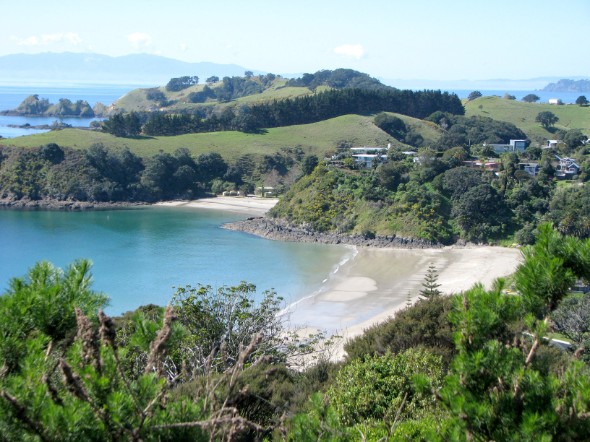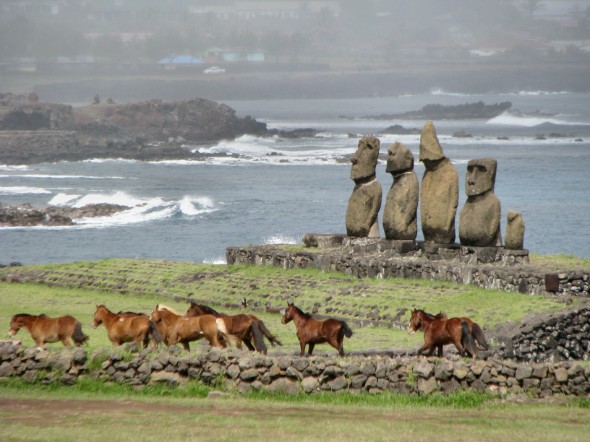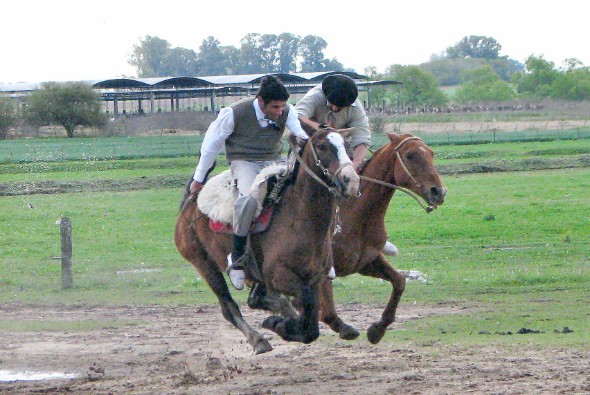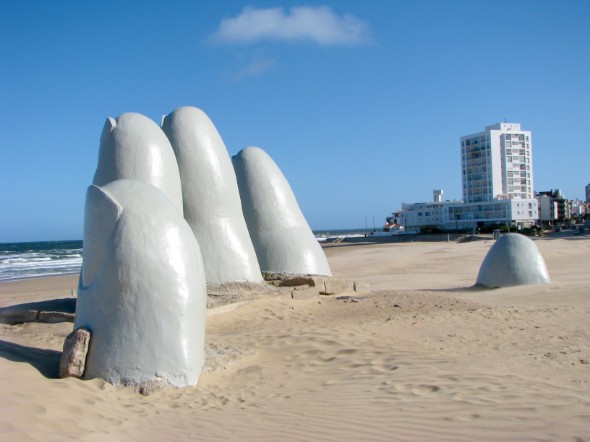<<< Previous
From Sydney, it is a three-hour flight across to New Zealand, where Auckland was in the delightful first buds of spring, fresh and welcoming.
Sky Tower dominates the Auckland skyline, and it is possible to make a controlled jump from the southern hemisphere's tallest free-standing structure, or simply watch from the revolving restaurant. New Zealanders seem besotted with throwing themselves off high places, and bungee jumping has the flavour of a national sport. The locals never tire of relating how leaping off a bridge tied to an elastic cord was made popular by a fellow Kiwi.
My
pleasures in Auckland reached their peak, however, amid the
spectacularly beautiful island scenery. Easily accessible by ferry
from the city harbour, Waiheke Island and the volcanic Rangitoto
Island were resplendent in the clear blue spring skies. A glass of
estate Chardonnay provided a little extra sparkle while overlooking
the sand and sea along the glorious stretch of Onetangi beach.

The Maori cultural centre and geothermal springs of Rotorua are an easy tour-ride away, and another short excursion out of Auckland gets you to the forests and waterfalls of the Waitakere Ranges Regional Park. On the black sand beach at Piha, I dangled my fingers into the Tasman Sea before heading further east.
Even after the impressive size of Australia, the expanse of the Pacific Ocean is stunning. However, the nature of the international dateline meant that it was possible to make a day-long journey from Auckland to Easter Island, via Santiago de Chile, and still arrive only a couple of hours after the departure time.
Easter
Island must be one of the world’s most unique destinations as well
as one of the most remote, being about 2,030 kilometres (1,260 miles)
from the nearest other inhabited land. Its history has caused much
speculation, and looking into the intense fixed stares of the
monolithic statues, the moai, felt like a form of time travel. In
addition, good hiking country surrounds the three volcanoes that
originally formed this 117 square kilometres (45 sq miles) of island,
palms adorn the sunbathing beach at Anakena, and the capital, Hanga
Roa, combines a good number of sights and flavours. A visit to the
anthropological museum followed by a plate of cheese empanadas
provided food for both mind and stomach.

Easter Island is usually reached through Santiago de Chile, which was my natural next stop. As much as Easter Island is unique, Santiago curiously seems to downplay its own identity. There is no central attraction that stands out as emblematic of the city, for example. This is not to say that there are no attractions. The hills of Cerro San Cristóbal and Cerro Santa Lucia provide wonderful, if smoggy, views across the city, and the former is home to a statue of the Virgin that partially echoes the more famous figure of Christ overlooking Rio. The cathedral, the Museum of Pre-Colombian Art, and the bustle of the Plaza de Armas also enrich the city. Santiago is, however, perhaps not the spiciest first taste of South America.
Across
the Andes, Buenos Aires
compensates. This is one of the continent's party capitals, where it
is impossible to avoid tango even if you don’t venture into a show
or lesson. Strolling around the barrios on a pleasant Sunday morning,
when the market in San Telmo was getting into its swing, was as
enjoyable as much as struggling through the traffic in the rain on
Friday night was not. Some barrios, like La Boca, have become known
as dangerous for tourists, but in the centre, a little common sense
should see you right. I had too much travel under my belt to dance
every night away, but this loss was admirably balanced by a trip out
of town to a gaucho ranch, the Estancia Don Silvano, to watch cowboy
stunts, eat prime Argentine steak, drink fruity Argentine wine, and
enjoy a bit more tango.

A
half-hour flight across the River Plate, Montevideo
is more sedate. Uruguay must be one of the best-kept secrets in South
America. Clean and attractive, with miles and miles of sandy beaches
and coves, the coastline breathes a seductive charm. Uruguay is
pleasantly quirky, too. The remarkable fairy-tale design of
Casapueblo, the villa and art gallery of the Uruguayan Picasso,
Carlos Páez Vilaró, at Punta Ballena, is picturesque to the point
of astonishing; and La Mano en la Arena, a giant sculpture of a hand
reaching out of the sand at Punta del Este, is endearingly eccentric.
There is tango in Uruguay, too, but after the hustle and bustle of
Buenos Aires, Montevideo was delightful for its peace and relaxation,
and also for its lack of tourists.

Its position in the east of South America makes Montevideo a good staging post for the journey back to Europe. A direct flight to Madrid brings a European traveller back to familiar ground. Here, in one of the old colonial centres of power, it is tempting to imagine a feeling of age and stature in the architecture, compared to a youthful eagerness in the former outreaches of empire. The grand buildings resound with bygone years, and the Madrid bull ring emanates the same sort of cultural pull as a coliseum or pantheon.
Madrid
shares the South American penchant for partying until dawn, but on
the last leg of my journey, I was also on my last legs for vigour.
After 58 days in eleven countries across four continents, I was ready
to stand still for a while. Arriving back at Helsinki-Vantaa
airport was a moment of sheer exhilaration. I had actually done it: I
had been around the world!
© Bruce Marsland 2010